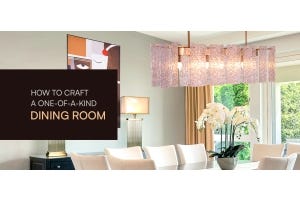5 Steps You Need to Take Before Installing Decorative Lights
So you’ve bought yourself a gorgeous new chandelier that’s the absolutely perfect piece for your home. The installation team is supposed to come in and put it in place so you can wow your guests with it this weekend. But at the last minute, you come to realize that your false ceiling is not strong enough to carry this chandelier and you don’t have the equipment to have it installed that day.
And just like that, your plans go out the window!
What a sad scenario!
Unfortunately, it’s more common than you might think. Decorative lighting fixtures are not like regular tube lights that an electrician can simply come in and put up. They require some basic groundwork to be laid for the electricians (pun intended!)
In this article, we will tell you everything you need to do before and during your decorative lighting installation to avoid any hiccups. Following these quick steps will help ensure that your gorgeous new lighting fixtures can be installed and used exactly the way you want them to be.
Step 1: Check Your Product
The first thing you need to do is open up the box in which your light arrives and take a look at the product. Although every brand takes the utmost care to make sure that your products reach you safely, some damages can still take place in transit. So, if you order a product with glass or other fragile material, you should open the box at the earliest and ensure that the product you have received is intact.
In case the product is damaged, you will save yourself a lot of time and energy by finding that out before calling in the installation team. Another reason why we recommend that you check your product as soon as it comes in is to ensure that you actually like it and it suits your place like you expect it to. Most companies (including The White Teak Company) have a 24-hour return policy, which means you may not be able to return the product more than a day after receiving it. You wouldn’t want to get stuck with something that doesn’t quite suit the plans you had for your house!
Step 2: Create Electrical Outlets
Once you’re convinced that the product is exactly what you need it to be, set about figuring out where you will place it. This is relatively easier for table lamps and floor lamps because those are easy to plug and play. The same won’t necessarily apply to wall lights, pendants, or chandeliers. Typically, these require electrical outlets exactly where you want to place them.
Installation teams will usually not be equipped to create electrical outlets, that’s something you will need to arrange for beforehand. So, get electrical outlets installed wherever necessary so that your newly bought decorative lights can receive what they need.
Remember to check the wattage necessary for the product you’ve purchased. Chandeliers, especially, tend to have a significantly higher power requirement than other decorative lights. Installing these in a circuit that cannot bear the electrical load can short-circuit your entire house. But of course, you can’t be expected to know and calculate all this yourself — that brings us conveniently to the next step.
Step 3: Check Installation Manual
Every good product comes with a manual full of all the details you need to know before you use the product. This is no different for gorgeous decorative lights.
In the manual, you will find all the details on the power requirements for the product as well as instructions on how to assemble and install it. Make it a point to read through these details. It’s always handy to know what you’re dealing with, even if you don’t fully understand the technicalities of it.
When you call in a team to install the electrical outlets, you will need to tell them how much power the chandelier or pendant is going to consume, especially if it’s a big and majestic piece like the Winter is Coming chandelier.
Keep in mind that the size of a chandelier has very little to do with how much electricity it consumes. The type and number of lights it has will determine this and not just the size. For example, although the Winter is Coming chandelier looks massive, it’s powered by just 8 Wifi-enabled LED spotlights, which means its consumption is unlikely to be very high.
If the consumption of a chandelier is not too high, you will only need to install simple electrical points to accommodate it. But for high-wattage chandeliers, you might need to have some of your circuitry redone. It’s best to have all this checked out and ready before the day of installation to make sure things go smoothly.
Step 4: Clean Up!
This may sound like a no-brainer but trust us, the smallest of things can make a huge difference. Typically, decorative lighting is installed in houses that are at various stages of construction. So the odds are that your house is still being built when the lighting comes in. That would usually mean that there is a lot of debris and hardware lying around. Even in cases where your house is already constructed, you might have gotten some electrical work done and there could be little things lying around. This can be hazardous when it comes to decorative lighting installation because it may cause direct or indirect damage to your newly bought lighting products.
For example, let's say there is a small screw on the floor and the electrician ends up stepping on it while carrying your chandelier. A worse case scenario would be if there is a bit of water on the floor that causes the electrician to slip with the chandelier in their hands. If you're VERY lucky, the chandelier won't get damaged, but those odds are extremely low. These are potentially disastrous scenarios that you would definitely want to avoid when your chandelier or other decorative lighting products are being installed.
When you clean the area, also make sure that there is no furniture that could get in the way of the technicians who are installing your products. It is generally a good idea to keep your furniture and upholstery covered with cloth or plastic sheets when this kind of work is getting done. This will help you protect your furniture from getting dusty or dirty in the process. Doing this before the installation team arrives will save you a lot of time as well.
Step 5: Coordinate with the Installation Team
Last but not the least, make sure that you speak to the installation team before they arrive. If you can, ask them for a list of equipment that they will require to install your product. Check if the same is available with them or whether you will need to provide it. This way, you can be sure that there will be no delays or hiccups in your installation due to unavailability of necessary material.
A good lighting company will provide an installation service along with its products, especially the fancier ones such as chandeliers. This is to help ensure that you don't have to suffer from any damage to the products due to mishandling by inexperienced technicians. We highly recommend taking any such services to make sure that the technicians who are handling your products know exactly what they are doing and do not, therefore, end up damaging the products. Technicians who are sent by The White Teak Company's installation service are trained extensively to provide nothing but the best service. More importantly, if any damages are caused to the products when our certified technicians are installing it, then replacement for the same is provided free of cost by us. If you get your own technician, however, you may have to bear the cost of any inadvertent damage caused by the technician.
We hope that you have found this article useful in helping you prepare your house for the installation of chandeliers and other decorative lights. Please let us know in the comments section if you have any additional tips or practices that you follow in this process!





